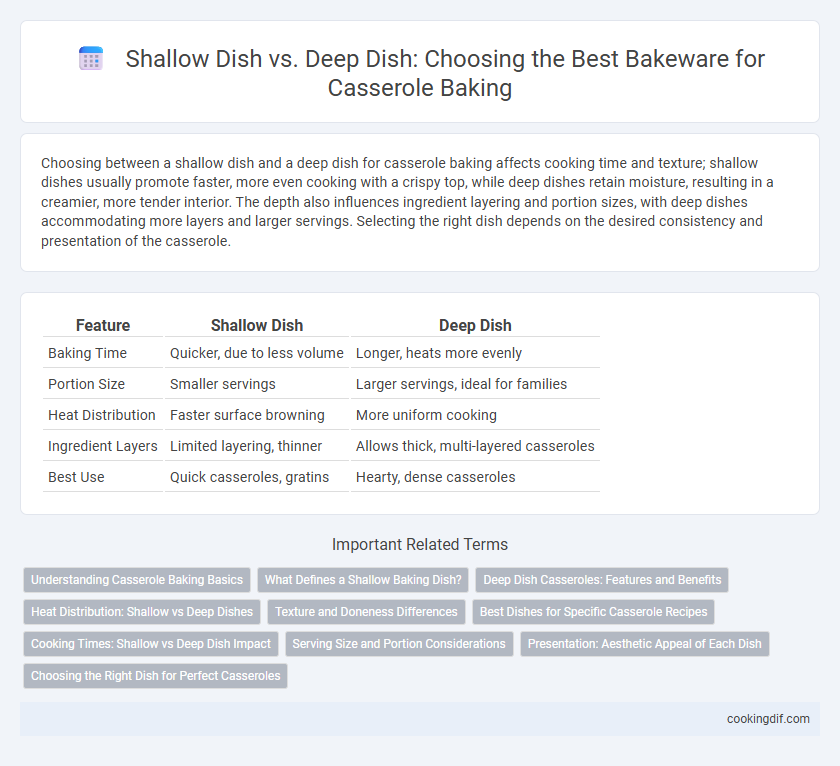Choosing between a shallow dish and a deep dish for casserole baking affects cooking time and texture; shallow dishes usually promote faster, more even cooking with a crispy top, while deep dishes retain moisture, resulting in a creamier, more tender interior. The depth also influences ingredient layering and portion sizes, with deep dishes accommodating more layers and larger servings. Selecting the right dish depends on the desired consistency and presentation of the casserole.
Table of Comparison
| Feature | Shallow Dish | Deep Dish |
|---|---|---|
| Baking Time | Quicker, due to less volume | Longer, heats more evenly |
| Portion Size | Smaller servings | Larger servings, ideal for families |
| Heat Distribution | Faster surface browning | More uniform cooking |
| Ingredient Layers | Limited layering, thinner | Allows thick, multi-layered casseroles |
| Best Use | Quick casseroles, gratins | Hearty, dense casseroles |
Understanding Casserole Baking Basics
Shallow casserole dishes promote even cooking and allow moisture to evaporate, preventing sogginess and ensuring a crispy top layer. Deep dishes hold more ingredients, ideal for recipes requiring longer cooking times to fully meld flavors but may result in uneven heat distribution. Selecting the proper depth depends on the casserole type and desired texture, balancing moisture retention and browning for optimal baking results.
What Defines a Shallow Baking Dish?
A shallow baking dish for casseroles typically has a depth of 1 to 2 inches, allowing for faster, more even cooking and effective browning on the surface. This type of dish prevents the casserole from becoming soggy by promoting moisture evaporation, ideal for recipes that require a crisp top layer. Ceramic, glass, or metal materials are commonly used, ensuring consistent heat distribution during baking.
Deep Dish Casseroles: Features and Benefits
Deep dish casseroles offer superior heat retention and even cooking due to their greater volume, making them ideal for layered dishes and recipes requiring longer bake times. The increased depth allows for more substantial ingredient quantities, ensuring hearty portions and enhanced flavor melding. Ceramic or glass deep dishes provide excellent thermal conductivity and aesthetic appeal, perfect for both cooking and serving.
Heat Distribution: Shallow vs Deep Dishes
Shallow dishes provide quicker heat distribution, allowing casseroles to cook more evenly and reducing the risk of undercooked centers. Deep dishes require longer cooking times due to their volume, which can lead to uneven heat penetration and hotspots. Choosing a shallow dish optimizes heat flow for consistent texture and flavor in casseroles.
Texture and Doneness Differences
Shallow dishes promote faster evaporation, resulting in a thicker, crispier crust and more evenly cooked toppings in casseroles. Deep dishes retain more moisture, producing a softer texture and sometimes requiring longer baking times to achieve thorough doneness. Choosing between shallow and deep casserole dishes directly impacts the final texture and moisture content of baked casseroles.
Best Dishes for Specific Casserole Recipes
Shallow dishes with a larger surface area are ideal for casseroles that require a crispy, browned top, such as au gratin potatoes or baked macaroni and cheese, as they promote even heat distribution and faster cooking. Deep dishes are better suited for recipes with thicker, layered ingredients like lasagna or chicken pot pie, allowing for thorough cooking and retaining moisture without overflow. Choosing the correct depth enhances texture and flavor, optimizing results for specific casserole recipes.
Cooking Times: Shallow vs Deep Dish Impact
Shallow casserole dishes typically reduce cooking times by allowing heat to penetrate more quickly and evenly, resulting in faster and more uniform baking. Deep dishes require longer cooking times to ensure the center is fully cooked, often necessitating lower oven temperatures to prevent over-browning on the edges. Selecting the appropriate dish depth influences both texture and moisture retention, with shallow dishes promoting crispier tops and deep dishes preserving more moisture in layered casseroles.
Serving Size and Portion Considerations
Shallow casserole dishes, typically 1-2 inches deep, are ideal for smaller portions and quicker, even baking, making them perfect for serving 4-6 people. Deep casserole dishes, often 3-4 inches deep, accommodate larger, layered recipes and are suited for serving 8-10 individuals or more, offering generous portions. Choosing the right depth ensures optimal cooking times and portion control, enhancing both presentation and meal satisfaction.
Presentation: Aesthetic Appeal of Each Dish
Shallow dishes enhance the presentation of casseroles by showcasing layered ingredients and creating an inviting, open appearance that entices diners. Deep dishes allow for taller, more substantial casseroles with a rustic charm, emphasizing volume and hearty portions that appeal visually to those seeking comfort food. The choice between shallow and deep dishes significantly influences the casserole's aesthetic appeal, with shallow dishes highlighting intricate details and deep dishes emphasizing abundance.
Choosing the Right Dish for Perfect Casseroles
Shallow dishes promote faster, even cooking and help achieve a crispier top layer, ideal for casseroles with a higher ratio of ingredients to sauce. Deep dishes retain moisture better and are perfect for recipes with ample liquid or layered ingredients, ensuring thorough cooking without drying out. Selecting the right dish size and depth is essential for balancing texture, cooking time, and flavor integration in casserole baking.
Shallow dish vs Deep dish for casserole baking Infographic

 cookingdif.com
cookingdif.com